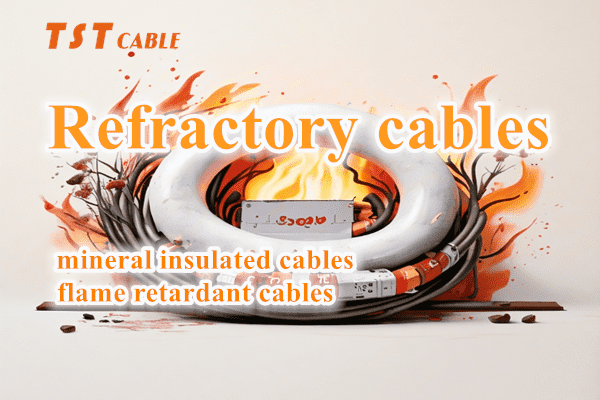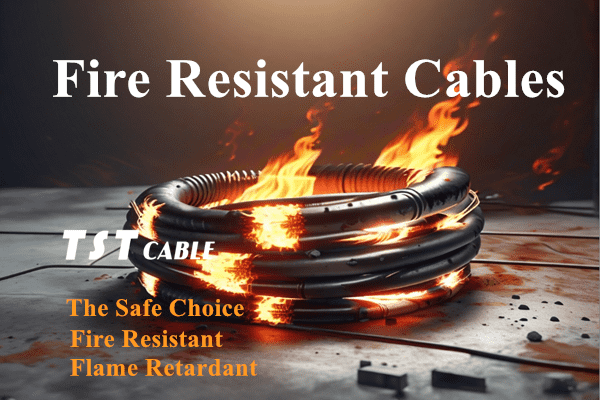
Difference between refractory cable and mineral insulated cable
Difference in composition and structure
- Mineral insulated cable: inorganic materials, non-combustible, does not produce harmful gases, when a fire occurs, smoke and gas is the most deadly, which is one of the biggest advantages of mineral-insulated cables. 250 ° C can be used for long periods of time, 950-1000 ° C continued to work for 3 hours, GB/T16895.15-2002 provides for the mineral-insulated cable working temperature of 105 ° C.
- Fire resistant cable: insulation material composition, low-halogen, low-smoke its own flame retardant or not in the assessment. In the event of a fire, to maintain a certain time of operation, that is, to maintain the integrity of the circuit, there is a certain time of power supply capacity. Fire resistant cable under special conditions working temperature up to 90 ° C, 950-1000 ° C continued to work for half an hour
Difference in power supply capacity
- Mineral insulated cables: the cut-off current is larger than that of refractory cables, which is equivalent to the cut-off surface of refractory cables is 1-3 cut-off surfaces less. That is, the same current passes through, but the volume is reduced.
- Refractory cables: power supply capacity is still an advantage over traditional cables.
Laying method and others
Mineral insulated cable: more than 50 years without maintenance and replacement (BTTZ cable life of more than 100 years), can be laid openly or directly buried to save the cost of cable bridges.
Refractory material: easy to aging, short life, after a period of time to be frequently maintained and replaced, late maintenance costs.
Fire-resistant cable. Fire-resistant cables are cables that can maintain safe operation for a certain period of time under the condition of flame combustion. Fire-resistant cables are widely used in high-rise buildings, underground railroads, underground streets, large power stations and important industrial and mining enterprises and other places related to fire safety and firefighting life-saving, for example, the power supply lines and control lines of firefighting equipment and emergency facilities such as emergency guide lights.
Mineral insulated cable. Mineral insulated cable, a kind of copper sheath wrapped copper conductor core, and magnesium oxide powder as the inorganic insulating material to isolate the conductor and the sheath of the cable, the outermost layer can be selected according to the need for appropriate protection sleeve. Commonly known as MICC or MI cable. There is a similar cable with metal instead of copper sheath wrapped core and insulation materials, called mineral insulated metal sheathed cable.
Difference between fire resistant cable and flame retardant cable
Difference in Principle
The principle of fire-resistant cable is different from that of flame-retardant cable. Halogen-containing cable flame retardant principle is to rely on the halogen flame retardant effect, halogen-free cable flame retardant principle is to rely on the precipitation of water to reduce the temperature to extinguish the fire. Fire-resistant cables rely on the fire-resistant layer of mica materials in the fire-resistant, heat-resistant properties to ensure that the cable in the fire also work properly. The representative fire-resistant cable in the ceramicized cable, as an emerging technology, it is the principle of such cables in the flame can form a self-supporting ceramic body, has a certain strength, thermal shock resistance and good electrical properties, in the 650 ~ 1000 ℃ high temperature of the flame, a certain period of time (0.5 ~ 2h) within the structural integrity of the cable can be very good play “Passive fire prevention” effect, for fire safety to win valuable time. It is also characterized by non-halogen, low smoke, low toxicity, self-extinguishing, environmental protection and easy processing.
Difference in structure and material
Fire-resistant cable and flame-retardant cable are also different in structure and material.
The basic structure of flame retardant cables is: the insulation layer is made of flame retardant materials, the sheath and outer jacket are made of flame retardant materials, and the wrapping and filling are made of flame retardant materials.
The fire-resistant cable is usually between the conductor and insulation layer plus a fire-resistant layer, so theoretically you can add a fire-resistant layer to the structure of the flame retardant cable, the formation of both fire-retardant and fire-resistant cables, but in practice there is no need for this. Because the fire-resistant layer of the fire-resistant cable, usually can use different fire-resistant materials directly covered in the wire. It can withstand prolonged burning, even if the polymer at the place where the flame is applied is burned, it can ensure the normal operation of the line.
Fireproof cable and fire-resistant cable difference
Fire-resistant wire and cable is a general term for wires and cables with fire-resistant properties, which are usually divided into two categories: flame-retardant wire and cable and fire-resistant wire and cable. The general public is very easy to confuse the concept of flame retardant cables and fire-resistant cables, although flame retardant cables have many advantages that are more applicable to the chemical industry, such as low halogen, low-smoke flame retardant, etc., but in general, fire-resistant cables can be replaced by fire-resistant cables, while fire-resistant cables can not be replaced by fire-resistant cables.
1. Difference in principle
The principle of fire-resistant cable is different from that of flame-retardant cable. Halogen-containing cable flame retardant principle is to rely on the halogen flame retardant effect, halogen-free cable flame retardant principle is to rely on the precipitation of water to reduce the temperature to extinguish the fire. Fire-resistant cables rely on the fire-resistant layer of mica materials in the fire-resistant, heat-resistant properties, to ensure that the cable in the fire also work properly. The representative fire-resistant cable in the ceramicized cable, as an emerging technology, it is the principle of such cables in the flame can form a self-supporting ceramic body, has a certain strength, thermal shock resistance and good electrical properties, in the 650 ~ 1000 ℃ high temperature of the flame, a certain period of time (0.5 ~ 2h) within the structural integrity of the cable can be very good play “Passive fire prevention” effect, for fire safety to win valuable time. And has no halogen, low smoke, low toxicity, self-extinguishing, environmental protection, easy to process and so on.
2. Difference in structure and material
Fire-resistant cable and flame-retardant cable are also different in structure and material.
The basic structure of fire-retardant cable is: the insulation layer is made of fire-retardant materials, the sheath and outer jacket are made of fire-retardant materials, and the wrapping and filling are made of fire-retardant materials.
Fire-resistant cable is usually between the conductor and insulation layer plus a fire-resistant layer, so theoretically you can add a fire-resistant layer in the structure of the flame-retardant cable, the formation of both flame-retardant and fire-resistant cables, but in practice there is no need for this. Because the fire-resistant layer of the fire-resistant cable, usually can use different fire-resistant materials directly covered in the wire. It can be resistant to prolonged combustion, even if the polymer at the applied flame is burned, but also to ensure the normal operation of the line.
Most of the fire-resistant cables are flame retardant cables, the main difference between fire-resistant cables and fire-resistant cables is that fire-resistant cables can maintain normal power supply (use) for a period of time in the event of a fire, whereas flame-resistant cables do not have this characteristic.
Fire-resistant cable refers to: under the specified test conditions, the specimen is burned in the flame, within a certain period of time can still maintain the normal operation of the performance.
The fundamental characteristic is: the cable can still maintain the normal operation of the line for a period of time under burning conditions. In layman’s terms, in case of fire, the cable will not burn at once, the circuit is safer.
Fireproof cable is characterized by neither combustion, nor delayed combustion; it is the use of special materials made of seamless copper tube as the sheath, magnesium oxide as the insulating material produced by the high efficiency of fireproof cable, common models are BTLY, YTTW, BBTRZ, HFTGB, BBTZ and so on. Experiments have shown that: in 800 ~ 900 ℃ in 2 hours, fireproof wire and cable is still normal operation, in 1000 ℃ in 30 minutes still continue to operate normally. But the cost is relatively expensive, and does not have the usual cable flexing. Currently in civil construction is mainly used to ensure personal and property safety in important places of special loads.
TSTCABLES is the world’s leading manufacturer of high-quality fire-resistant cables
TSTCABLES fire-resistant cables, the safe choice! Our fire-resistant cables are manufactured from high-quality materials and rigorously tested to ensure consistent performance even under extreme conditions. Its excellent fire resistance characteristics, the use of new high-quality flame-retardant materials, durable, effective in reducing safety hazards, able to keep the circuit open in the fire, for your equipment and life safety.
Also available in:
English



